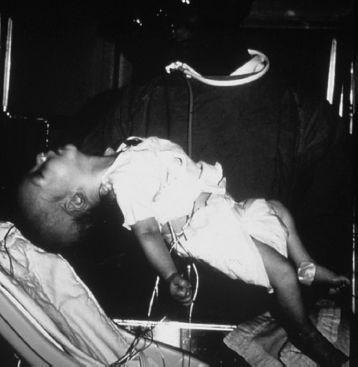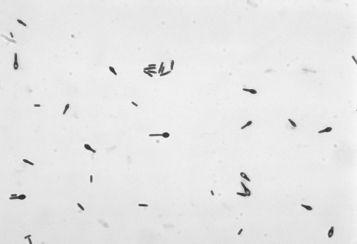Pediatric Examination and Board Review (16 page)
Read Pediatric Examination and Board Review Online
Authors: Robert Daum,Jason Canel

(B) EMG
(C) polysomnography
(D) steady state evoked potential (SSEP)
(E) MRI of the brain
4.
The clinical hallmarks of infant botulism are
(A) muscle weakness and constipation
(B) muscle weakness and hypotension
(C) muscle weakness and ptosis
(D) muscle weakness and head lag
(E) muscle weakness and fever
5.
The cause of infant botulism is
(A)
Clostridium botulinum
bacteria
(B)
Clostridium botulinum
toxin
(C)
Clostridium difficile
bacteria
(D)
Clostridium difficile
toxin
(E) none of the above
6.
The manner in which most infants contract botulism is
(A) ingestion of
Clostridium
spores in food
(B) inhalation of
Clostridium
spores
(C) fecal-oral contamination with
Clostridium
bacteria
(D) blood-borne infection with
Clostridium
bacteria
(E) blood-borne infection with
Clostridium
spores
7.
Of the following, the infant most likely to have botulism is
(A) a 15-month-old who was given home-canned peaches by her grandmother
(B) a 1-month-old who was given honey-dipped pacifiers for “colic”
(C) a 3-month-old living in Philadelphia in a subdivision under construction
(D) a 9-month-old who is living in urban Chicago in public housing
(E) a 6-month-old formula-fed infant living in Miami
8.
The incubation period for infant botulism is
(A) 3-5 days
(B) 7-10 days
(C) 2-4 weeks
(D) 6-8 weeks
(E) 4-6 months
9.
The symptoms of botulism occur because there is
(A) generalized degeneration of the anterior horn cells in the spinal cord
(B) reversible blockade of the acetylcholine receptor at the motor end plate
(C) inflammation of the myofibrils of somatic muscle
(D) an irreversible block of the release of acetylcholine at the motor end plate
(E) demyelination of the spinal cord white matter
10.
Medications that might potentiate botulism include
(A) cephalosporins
(B) nonsteroidal anti-inflammatory drugs (NSAIDs)
(C) aminoglycosides
(D) antihistamines
(E) gastrointestinal (GI) motility agents
11.
Possible in-hospital issue(s) in an infant with botulism include
(A) respiratory failure
(B) autonomic instability
(C) feeding intolerance
(D) nosocomial infection
(E) all of the above
12.
Which of the following findings least supports an alternative diagnosis of Werdnig-Hoffman disease in this low-tone infant?
(A) weakness
(B) wasting
(C) constipation
(D) absence of tendon reflexes
(E) none of the above
13.
In Werdnig-Hoffman disease, the affected anatomic structures are
(A) the alpha motor neurons
(B) the motor end plates
(C) the muscle membranes
(D) the myelin sheaths of peripheral nerves
(E) A and D
14.
In polio, the affected anatomic structures of the nervous system are
(A) the alpha motor neurons
(B) the motor end plates
(C) the muscle membranes
(D) the myelin sheaths of peripheral nerves
(E) A and D
15.
In Guillain-Barré disease, the affected anatomic structures in the nervous system are
(A) the alpha motor neurons
(B) the motor end plates
(C) the muscle membranes
(D) the myelin sheaths of peripheral nerves
(E) the myofibrils
16.
With pancuronium use, the affected anatomic structures in the nervous system are
(A) the alpha motor neurons
(B) the motor end plates
(C) the muscle membranes
(D) the myelin sheaths of peripheral nerves
(E) A and B
ANSWERS
1.
(D)
This case raises the lengthy differential diagnosis of “the floppy infant,” or hypotonia (
Figure 7-1
). This particular child presented with a concomitant prominent history of constipation, which may direct physicians toward a diagnosis of either infant botulism or hypothyroidism. Although endemic polio has been largely absent from the United States in the 21st century, a history of foreign travel to an endemic area might suggest the diagnosis of polio. The diagnosis of Guillain-Barré syndrome must be considered as well. In a 4-month-old, Guillain-Barré is also unusual. Although congenital or infantile hypothyroidism becomes apparent at this age, it is unlikely to be missed by newborn testing in the United States. Acquired hypothyroidism is rare in this age range. Thyroid function tests certainly should be sent and the results of the child’s newborn screening should be checked. Amyotrophic lateral sclerosis (Lou Gehrig disease) is a disease of adults. Werdnig-Hoffman, or infantile spinal muscle atrophy, is a slowly progressive disease that presents with a longer duration of symptoms.

FIGURE 7-1.
Infant botulism. The floppy-constipated baby is a classic presentation of infantile botulism. (Courtesy of the Centers for Disease Control and Prevention.)
2.
(C)
The diagnosis of infant botulism is largely based on significant clinical suspicion. A presumptive diagnosis must be made based on clinical presentation while confirmatory studies are pending. Once suspected, stool samples can be sent to the Centers for Disease Control and Prevention for identification of
C botulinum
toxin. Do remember, however, that these patients are frequently constipated, so the acquisition of that stool specimen may take some time and does not always yield positive results.
3.
(B)
EMG testing can be performed on infants with suspected botulism. Classic findings include decreased amplitude of compound muscle action potentials, tetanic facilitation, and the absence of post-tetanic exhaustion. These EMG findings, nonetheless, are not pathognomonic, and the EMG may be normal early in the course of the disease.
4.
(A)
The presentation and severity of the disease can be very variable and, for unknown reasons, it appears to be more common in breastfed babies. The initial presentation may simply involve constipation and some feeding difficulty. If left unrecognized and unsupported, the patient may progress to global hypotonia, drooling, inability to eat, and respiratory failure. Symptoms will progress for 1-3 weeks before a plateau is reached, at which time the clinical condition stabilizes for another 2-3 weeks and recovery begins. Should the child need to be hospitalized, intubated, and ventilated, the hospital stay is frequently 3-6 weeks.
5.
(B)
Botulism is a rare but potentially fatal neuroparalytic disease, resulting from the action of a neurotoxin synthesized by
C botulinum
. Seen in only 100 U.S. children each year, infant botulism is a disease that occurs in the first year of life. The presentation and severity of the disease is very variable.
6.
(B)
The toxin is usually acquired by ingestion of
C botulinum
spores followed by their germination in the GI tract (see
Figure 7-2
).

FIGURE 7-2.
Clostridium botulinum
.
Clostridium botulinum
is a gram-positive rod that will have terminal or subterminal spores. The spores are heat resistant. (Courtesy of the Centers for Disease Control and Prevention.)
7.
(C)
Spores can be acquired from 1 of 2 sources in infants: exposure to contaminated soil or exposure to contaminated food. Although more widely publicized, the incidence of botulism acquired from food represents only 15-20% of cases of infant botulism. Notoriously contaminated food products are homecanned fruits and raw honey. More commonly, spores are acquired by inhalation and then swallowed (ingested) from soil with a high concentration of
C botulinum
spores. States with the highest soil concentrations of spores include Utah, Pennsylvania, and California.
8.
(C)
Once germinated,
C botulinum
bacteria release toxin over 2-4 weeks and symptoms begin to be noted by the family.
9.
(D)
Neuromuscular transmission begins at the anterior horn cell of the motor nerve in the spinal cord, which is directed at the part of the anatomy receiving the signal for muscular activity. Electrical signals are transmitted down the myelinated peripheral nerve. The myelin sheath is responsible for the rapidity of transmission of that neural impulse, not the nervous impulse itself. At the peripheral nerve ending there is release of acetylcholine into the synaptic cleft separating the peripheral nerve from the motor endplate, which is located on the muscle membrane. Acetylcholine attaches to receptors on the motor endplate causing depolarization of the muscle and muscle activity.
